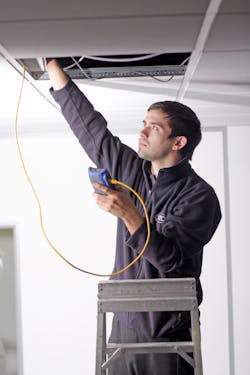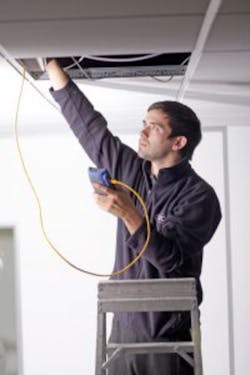Overcome network troubleshooting challenges in hospitals
Warrington, UK. IDEAL Networks is touting its NaviTEK NT network troubleshooting tester as a tool to help Overcome network troubleshooting challenges in hospitals. The company says that as mobile device use increases, hospitals rely ever more on IT networks, making it mission critical that network downtime is minimized and issues are rectified quickly.
Tim Widdershoven, the company’s global marketing manager, explains some of the common network troubleshooting challenges encountered in hospitals and how IT technicians can efficiently overcome them:
Challenge: Troubleshooting on the move
Many technicians will use a laptop for troubleshooting, which is heavy to carry and far from ideal when not working at a desk. Log-in via a laptop can take some time, batteries can run out quickly, and the size of the laptop can make it very difficult to work in small spaces. In addition, carrying a laptop around risks damage to, or theft of, an expensive piece of equipment.
Solution: The NaviTEK NT network troubleshooting tester lightens the load for IT technicians, who need to carry various kits from site to site within a hospital. It is easier for IT technicians to carry the handheld tester, and it makes working in a small space simple and comfortable. The tester also offers instant network access with no log-in required, plus extensive battery life.
Challenge: Increased Wi-Fi device usage
Use of Wi-Fi devices is increasing in hospitals, from visitors using guest Internet access to nurses recording patient observations on mobile devices and specialists assessing patients via bedside video-conference screens. This results in a need for more Wi-Fi access points, which in turn means more data cabling linking the access points to a switch. The increased amount of data cabling requires more management and troubleshooting and makes it more difficult to maintain a robust and reliable network.
Some hospitals have hundreds or thousands of wireless access points, supporting everything from phones to medical equipment. Due to the need for patient confidentiality and private networks, it is also not unusual to find 50 VLANs on site. A laptop is unable to conduct the wide range of tests that IT Technicians may require for troubleshooting within this infrastructure.
Solution: Unlike a laptop, a tester such as NaviTEK NT can offer physical measurements of both copper and fiber cabling, which improves troubleshooting and reduces network downtime.
Where labelling hasn’t been done correctly, finding the right port or switch to plug into is usually a case of trial and error. However, NaviTEK NT clearly shows technicians whether they are on the right port, so they can test for connectivity and troubleshoot more quickly. In addition, NaviTEK NT can connect to VLANs easily, a difficult task when using a laptop.
Challenge: Avoiding inaccuracy
In a hospital, it’s vital to diagnose issues quickly, so accurate test data is key. However, if the wrong tester is being used, technicians can misdiagnose faults on a cable and delay the troubleshooting process. Inaccuracies can also lead to additional costs, where external engineers are called in to fix a problem that doesn’t exist.
Incorrect configurations are another major cause of network downtime and are frequent within hospitals with so many different people and teams involved in managing networks. It can be difficult for IT technicians to prove the cause of an issue to network infrastructure engineers without the right test equipment.
Solution: NaviTEK NT can test across multiple infrastructures and presents the results on easy to understand PDF reports. The tester offers accurate wire mapping, including length measurement and distance to fault. It also means that reports can be generated quickly and easily. These clearly demonstrate incorrect configurations to other network teams and engineers, while also providing documentation of the network and PoE if required.
About the Author

Rick Nelson
Contributing Editor
Rick is currently Contributing Technical Editor. He was Executive Editor for EE in 2011-2018. Previously he served on several publications, including EDN and Vision Systems Design, and has received awards for signed editorials from the American Society of Business Publication Editors. He began as a design engineer at General Electric and Litton Industries and earned a BSEE degree from Penn State.

